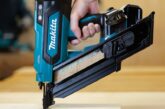
Kevin Brannigan Marketing Manager at Makita explains the benefits of modern cordless lighting and what to consider when choosing the right options for the job.
Winter brings with it shorter days and less natural light, which means additional artificial lighting is often required. The Health and Safety Act 1974, requires all sites have appropriate lighting so work can be undertaken effectively and safely and this is further underlined by the Health and Safety Executive (HSE), which outlines: “Where natural light is inadequate or not available, artificial lighting should be provided.”
Cordless lighting can provide a simple and versatile solution for use on many types of job site, helping to provide a clearer view of the materials being worked on and ensuring that potential hazards are visible – all year round!

Why choose cordless?
Traditionally, the only way to achieve good quality light on site was with mains powered lighting solutions. While this is effective in many cases, it does bring with it its own set of challenges, such as securing a power supply and routing the cable safely through the work area or managing portable generators. By contrast, cordless lighting removes this time-consuming element as well as eliminating the trip hazard that cables can present. The lights can be taken out of the van and set up in a matter of seconds with no need to think about where the power sources on site are located. This also means greater flexibility. Without the cables to consider, the lights can be placed in the optimum position to deliver the best possible illumination to the work area.
One of the misconceptions around cordless lighting is that it does not offer the levels of illumination to match those of mains powered options, or that the run times are not long enough to be practical. However, with advances in battery technology and the use of LED lighting, cordless is more than a match. For example, the Makita ML009G work light can provide 4,000 lumens of light for up to 6.5 hours on a single charge using a 4.0Ah 40VMax XGT battery. Where more illumination is required, it can deliver up to 10,000 lumens for more than two hours of continuous run time.

Selecting the right cordless lighting
The first factor to consider is what the lighting is needed for. There are broadly two types of portable lighting – area work lights and task lights. Area work lights, as the name suggests, are designed for a wide area, providing more general illumination. In fact, there are cordless products available that can deliver 360º lighting, enabling one unit to light up the entire workspace. Task lights are a more compact and highly portable solution, a flashlight-type product, that provides direct illumination to a specific area. These are ideal for improved visibility in confined spaces.
Another consideration is the battery platform that the lighting uses. It is beneficial to select products that use the same battery system as other tools that you already own. For example, several of the Makita work lights can operate using either the 18V LXT or 40VMax XGT batteries, which also power hundreds of other tools across the Makita range. Having one battery platform means there is no need to have different batteries and chargers in the van, and batteries can be swapped between the power tools and lights as required.
A further factor to keep in mind is the durability of the lights to ensure that they are suitable for conditions on-site and that they are robust enough to withstand any accidental damage. It is also worth noting that products that are IP65 rated will offer the highest level of resistance against dust and debris ingress as well as resistance to splashing, falling or dripping water, plus hose-directed water and condensation.
Ensuring good lighting on site is an important consideration and cordless lighting can provide the required levels of illumination and the simplicity and flexibility to help streamline the day’s work.
To find out more about Makita’s range of lighting solutions visit www.makitauk.com.







